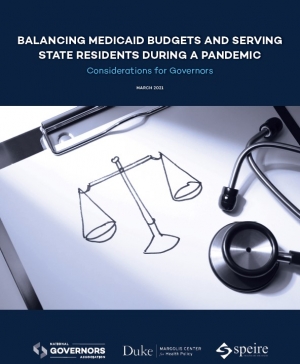
Policy Brief
Balancing Medicaid Budgets and Serving State Residents During a Pandemic
Published date
Governors are faced with unprecedented challenges as a result of the COVID-19 pandemic. States are largely responsible for the frontline public health response and for rapidly developing and implementing policies to serve residents affected by the pandemic.
The pandemic and the resulting strained health care system and economic downturn created unprecedented challenges, further complicated by the uncertainty of the duration of the pandemic. As a result, states face mixed and unpredictable budgets, with the situation depending on their primary sources of revenue, how hard hit the state is by the pandemic, and how quickly they will be able to recover. For many states, revenues declined and remain low and demand for critical social and safety net services is continuing to increase. Temporary, short term federal support has helped, however, states continue to face uncertain futures and Governors must balance budgets, maintain a strong economy, and support residents impacted by the pandemic. Many of the residents most affected by the pandemic are lower-income and often served by state Medicaid programs. Medicaid programs, which required significant state funding before the pandemic, are further straining state budgets because economic downturns increase enrollment. As a countercyclical program, Medicaid experiences increased enrollment during times of economic stress. High unemployment, among other factors, has increased Medicaid enrollment.
Along with unemployment due to the pandemic, state residents have experienced housing insecurity, food scarcity, and challenges paying for usual household expenses. Social determinants of health, such as income, education, access to safe and affordable housing, availability of nutritious food, and physical conditions of communities—impact individual and population health outcomes. As a result, the need for the social safety net is greater than ever.
This paper outlines key factors for Governors and state leaders to consider when balancing state budgets and making difficult decisions about funding Medicaid during the COVID-19 crisis and subsequent economic downturn. It explores the challenges faced by states, the role of Medicaid and the strategies implemented in prior recessions to lower state costs and maintain enrollment. For example, Medicaid agencies may be asked to reduce spending because of a decrease in state revenue while Medicaid enrollment is growing. Governors and state leaders will need to carefully consider potential changes to the program as the demand for services increases.
